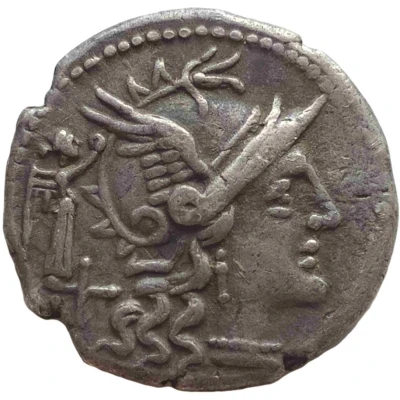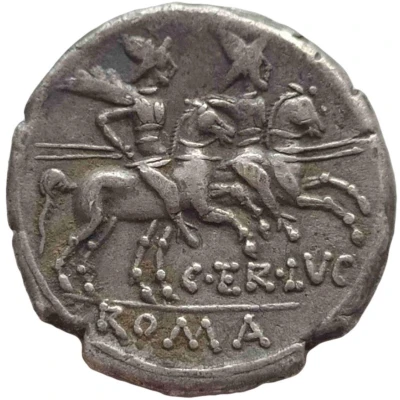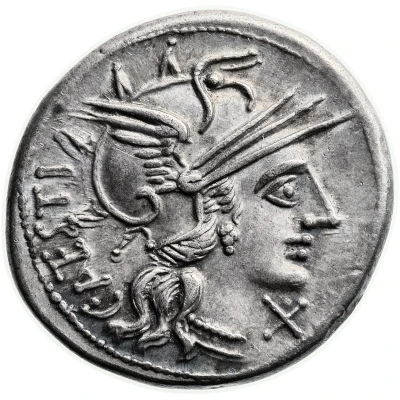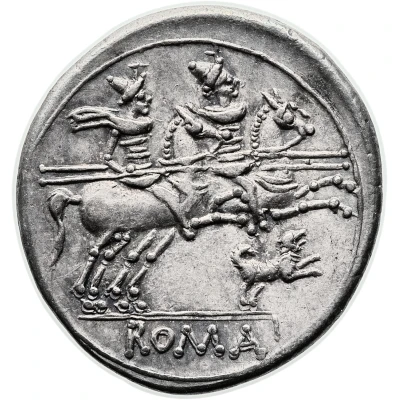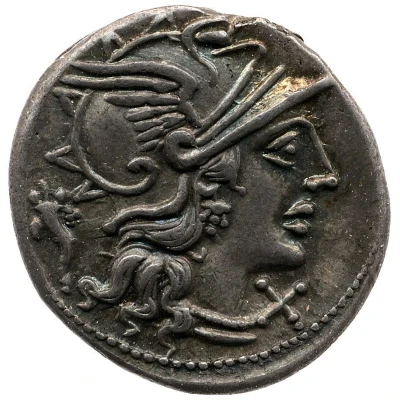


© British Museum
Denarius Cupiennia: Lucius Cupiennus; L C VP ROMA 147 BC
147 BC year| Silver (.950) | 3.58 g | 18.4 mm |
| Issuer | Rome › Roman Republic (509 BC - 27 BC) |
|---|---|
| Period | Republic (509 BC - 27 BC) |
| Type | Standard circulation coin |
| Year | 147 BC |
| Value | Denarius (1) |
| Currency | Denarius of 10 Asses (221 – 141 BC) |
| Composition | Silver (.950) |
| Weight | 3.58 g |
| Diameter | 18.4 mm |
| Shape | Round (irregular) |
| Technique | Hammered |
| Orientation | Variable alignment ↺ |
| Demonetized | Yes |
| Updated | 2024-10-06 |
| Numista | N#191010 |
|---|---|
| Rarity index | 90% |
Reverse
Dioscuri on horseback galloping right, cloak floating behind, each holding an horizontal spear, two stars above; below, moneyer mark; inscription in exergue.
Script: Latin
Lettering:
L. C (VP)
ROMA
Translation: Lucius Cvpiennus
Comment
The Cupiennii are only mentioned by the authors at the end of the Republic and the beginning of the empire. C. Cupiennius was friend of Cicero, who wrote him a letter in the year 710 (44 BC). Another Cupiennius is attacked by Horace who mentions him in a verse from his Satires. The poet accuses him of adultery, and it is known by the scholastic that it is about C. Cupiennius Libo, of Cumes, one of the friends of Augustus.There are still other Cupiennii in Campania. On money that dates back to around 590 (164 BC), we read L. CVP. that we interpreted by Lucius Cupiennius. Perhaps we could also read Lucius Cupitus, and attribute these currencies to L. Cocceius Cupitis, known in history. Borghesi gives them preferably to an unknown Cupiennius. As there is a copia (cornucopia) behind the head of Roma, this scientist recognizes, presumably, an allusion to the name of Cupiennius or Copiennius. For the same reason one could propose to give to a member of the Cupiennia family coins without name of monetary which carry a cornucopia for symbol. The denier of L. Cupiennius is of a style analogous to that of Cn. Lucretius Trio.
Interesting fact
The Denarius coin was issued during the Roman Republic, specifically in 147 BC. It features an image of the Roman goddess Venus on the obverse (front side) and a mythological scene on the reverse (back side). The coin was made of silver with a purity of .950, which means it contained 95% silver and 5% other metals. The weight of the coin was 3.58 grams. Interestingly, the Denarius was the main currency used in ancient Rome and was widely accepted throughout the Roman Empire. It was used for everyday transactions, such as buying goods and services, and was also used to pay taxes and soldiers' wages. The Denarius was an important symbol of Roman power and influence, and its design and purity were strictly regulated by the Roman government.
